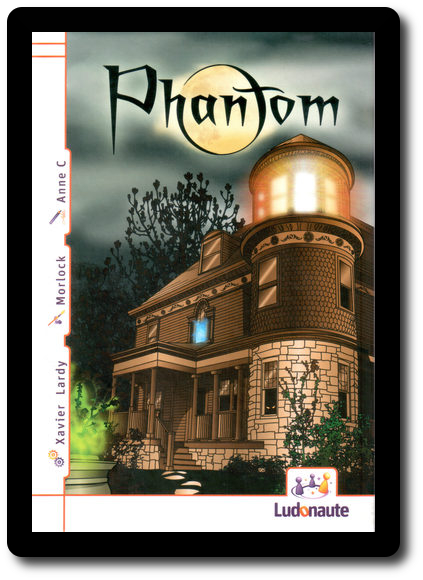
The Basics:
- For ages 8 and up (publisher suggests 10+)
- For 2 players
- Approximately 30 minutes to complete
Geek Skills:
- Active Listening & Communication
- Counting & Math
- Logical & Critical Decision Making
- Reading
- Pattern/Color Matching
- Strategy & Tactics
- Hand/Resource Management
- Worker Placement & Area Control
Learning Curve:
- Child – Easy
- Adult – Easy
Theme & Narrative:
- The living beware; only the dead dwell here
Endorsements:
- Gamer Geek mixed!
- Parent Geek mixed!
- Child Geek rejected!
Overview
Two powerful and angry spirits dwell in the old mansion. One is said to be the spirit of a great Indian Chief and the other an English settler. They killed each other, or so one story goes, and their spirits are still at war. Each phantom gathers to them ghosts and specters to control different areas of the house. Now a family has purchased the home and looks to move in. The have unwittingly walked into a supernatural war zone.
Phantom, designed by Xavier Lardy and published by Ludonaute, is comprised of 32 Phantom cards, 26 Place cards, 8 Character cards, 4 Zone cards, and 2 Reference cards. The cards are as thick and as durable as your standard playing card. The illustrations by Morlock are outstanding, capturing the eerie theme of the game and strengthening the underlying narrative.
The Haunting Hour
To set up the game, have the 2 players sit across from each other. Decide which player will be the Indian Chief phantom and which will be the English settler phantom. The Indian Chief phantom always goes first.
Second, set up the house to be haunted by placing the Zone cards in a row between the 2 players. They need to be in the following order, from the first player’s left to right: “Garden”, “Basement”, “Ground Floor”, and “Upstairs”.
Third, find the “Garage”, “Storeroom”, “Fountain”, and “Library” Place cards. The first player places the “Garage” Place card on their side next to the “Basement” Zone card. The second player places the “Storeroom” Place card next to the “Basement” Zone card, the “Fountain” Place card next to the “Garden” Zone card, and the “Library” Place card in front of the “Ground Floor” Zone card on their side. The second player should make certain there is enough room for another row of cards between their Place cards and the previously placed Zone cards. Shuffle the remaining Place cards and place them face-down at one end of the Zone card row. Leave room for a discard pile.
Fourth, find and remove the “Wilson Exorcist” Character card and then shuffle the remaining Character cards. Draw the top-most card and place the Character card face-up next to the “Upstairs” Zone card. The Character card should be between the Zone card and the second player’s Place cards. Place the “Wilson Exorcist” Character card face-up at the end of the Zone row where the “Garden” Zone is located. On top of the “Wilson Exorcist” Character card, place the remaining Character cards face-down. This is the Character card draw deck for the duration of the game.
Fifth, shuffle the Phantom cards and place the deck next to the Place deck, face-down, leaving room for a discard pile.
Sixth, deal to each player 3 Phantom cards, 3 Place cards, and 1 Reference card. The Reference card is placed in front of the player. From the remaining cards in the player’s hand, each player will select 1 Phantom card to discard. Once discarded, each player will have 3 Place cards and 2 Phantom cards. The initial discard pile for Phantom cards is created by the players’ discarded Phantom cards.
That’s it for game set up. The player who elected to be the ghost of the Indian Chief goes first.
Bumps and Screams in the Night
Phantom is played in turns with no set number of turns per game. A player’s turn is comprised of 4 Activations, one per Zone card in play. The order in which the Zone cards are activated is up to the player. Each Zone card has step-by-step instructions that must be followed. A player can also optionally play a card from their hand. Each of the step-by-step actions per Zone card are summarized here.
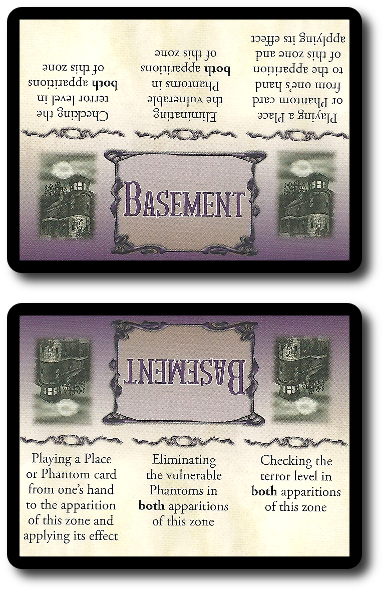
Zone cards are rotated to help players keep track of activations
Step 1: Play One Place or Phantom Card
The player has two cards they can play.
Place Cards
Place cards represent the different locations in the house. They are always attached to a Zone card and only to the Zone card currently being Activated. Each Place card lists which Zone it can be attached to, as well. As soon as a Place card in played, it creates an Apparition. Apparitions are either Places or Phantoms and represent specific areas of supernatural activity and power.
Each Place card has a Phantom capacity, indicating how many Phantom cards can be placed on that specific Place card. Place cards can also be placed on top of previously placed Apparitions. By doing so, the values are added together.
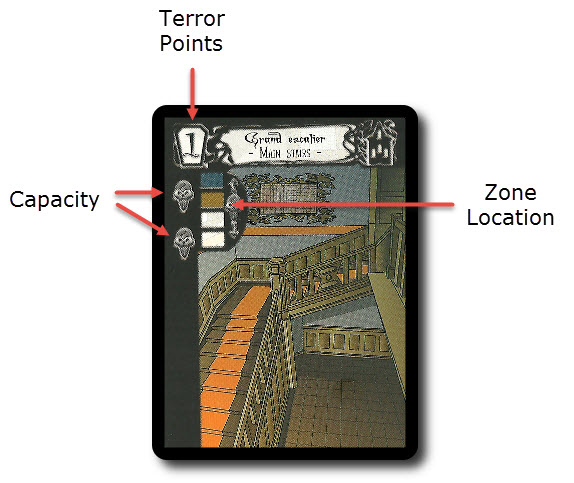
Six Place cards can be placed in 2 different Zones. These Place cards can be used by the player to optionally “Gather Power”. If they chose to do so, the player may add to the new Place card up to 2 Phantom cards taken from the other Zone. The taken Phantom cards must be available and no additional benefits are applied.
Phantom Cards
Phantom cards represent the souls and ghosts trapped in the house and under the player’s control. Phantom cards cannot be played to a Zone without a Place card first being located there. The number of Phantom cards that can be placed to any Place card is based on the Place card Phantom capacity. If a Place card has reached its capacity, additional Phantom cards cannot haunt there.
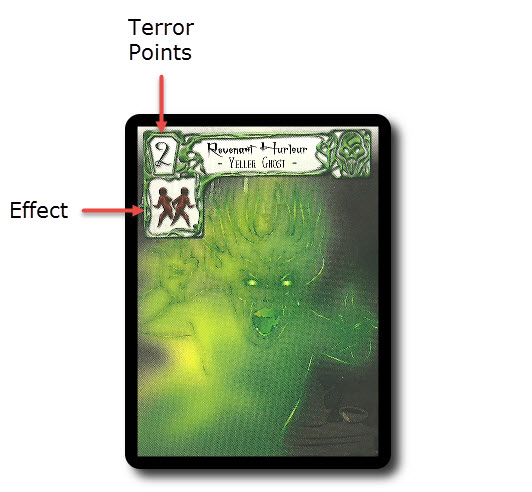
In total, there are 4 different groups of ghosts and specters (Specters, Ghosts, Shadows, and Souls – consider them like a card’s suit). There are 6 different types of Phantoms the players can control. Once played, Phantoms trigger an effect. Each effect is summarized here and on the Reference card.
- Charmer: Allows the player to tack 1 Character card from an adjacent Zone or draw 1 Character card and add it to the current Zone if it’s empty.
- Yeller: The opposite effect of a Charmer, moving all Character cards currently on the active Zone to an adjacent Zone or back to the Character draw deck.
- Queen: The Queen draws other Phantom cards to her that are of the same group, luring them in from the player’s opponent’s side of the Zone cards.
- Poltergeist: Destructive and noisy, this card allows the player to force their opponent to discard a free Phantom.
- Invoker: The first Phantom on top of the Phantom discard pile is taken by the player and added to the active Zone.
- Squatter: This nasty card allows the player to grab an occupied Place card from their opponent and add it to their active Zone.
Step 2: Eliminate Vulnerable Phantoms
After playing a card, the player now determines if any of the Phantoms are destroyed. Several of the Character cards are adults. The adult Character cards have special abilities that allow them to banish 1 group of Phantoms that are located in the same Zone as they are, but only if the Zone is currently active. There are Place cards that protect specific Phantom groups, as well. If the Character card banishes the Phantom group the Place card protects, the two powers cancel each other out. Otherwise, all the Phantom cards that match the same group the Character card banishes are taken from both the player’s side and their opponent’s side that are currently located in the active Zone and then discarded. The active player goes first, followed by the opponent. The Phantom cards are discarded in the order in which they were played.
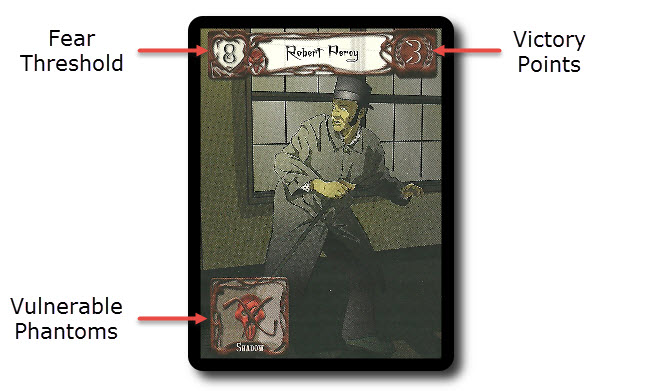
Step 3: Check Terror Level
The player now determines the total Terror Level for the active Zone by counting their own Phantoms (not their opponent’s). “Charmer” and “Invoker” Phantoms are worth 1 Terror point each. “Yeller” and “Poltergeist” Phantom cards are worth 2 Terror points each. The “Queen” is worth 1 Terror point for every Phantom card that is in the same group and the “Squatter” is worth 1 Terror point for every Place card located on the Zone card. Place cards can also provide Terror points.
After the points are all added together, the player determines if they have terrified the Character card located at the active Zone. A Character is terrified if the following conditions are met:
- The Character card must be the only one located at the active Zone.
- The total Terror must be equal to or higher than the Character card’s Fear Threshold value.
If the Character card is not scared, it remains where it is.
If the Character card is scared, it’s removed and given to the player. This Character card will be worth victory points at the end of the game. Then all the Place and Phantom cards are discarded from the active Zone, resulting in the Zone card being empty on the player’s side. The player’s opponent does not remove their cards.
This ends the player’s turn. The player now draws cards from the Place or the Phantom deck until they have a total of 5 cards in their hand.
The next payer in turn order sequence now goes.
Introducing the Exorcist and Ending the Game
When the last Character card is brought into play, the “Wilson Exorcist” Character card is added to it, increasing the Character card’s Fear Threshold by +2. These 2 Character cards travel together as a pair and are considered 1 card when determining the Terror level.
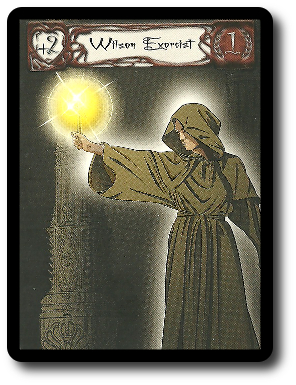
The game ends when one player has collected 11 or more points from Character cards. The game can also end if there are no more cards to be drawn from the discard pile or the draw piles. The player with the most victory points wins the game.
To learn more about Phantom, visit the game’s web page.
Final Word
The Child Geeks were excited about the game’s concept and really enjoyed the cards. The game play itself somewhat disappointed them. According to one Child Geek, “I understand how to play the game just fine, but I don’t feel like I’m a ghost or I’m leading ghosts.” Another Child Geek said, “What I like the most about the game is moving Phantoms around and forcing Characters to move, but wow, is that hard to do when you have an opponent who is always messing things up.” None of the Child Geeks we played with had problems learning how to play the game and demonstrated good game play. What the majority of them didn’t like was how long the game took to get interesting. As one Child Geek put it, “I like the idea of the game, but not playing the game.” The majority of Child Geeks voted to not approve Phantom, finding it to be a game they understood how to play, but not a game they wanted to play.
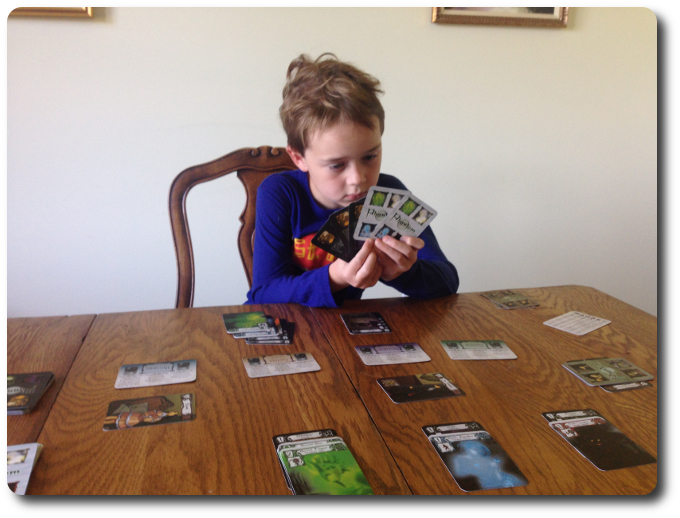
My 8-year-old son carefully considers his options as the house grows increasingly more haunted
The Parent Geeks fell into two groups. Those Parent Geeks who enjoyed 2-player games liked Phantom very much. According to one of these Parent Geeks, “I really enjoyed this game. You have to carefully plan each of your Zone activations and what cards you want to use. If you do it right, you can manipulate everything in the game.” Those Parent Geeks who did not enjoy 2-player games found nothing to like in Phantom beside the illustrations. According to one of these Parent Geeks, “I’m not a fan of 2-player games in general and this game did nothing to change my mind. I was bored and frustrated. When I played a card to shift the game to the right, my opponent shifted it to the left. I’d rather play a game that felt like I was always moving forward, versus taking 2 steps back each time I advanced.” In the end, the Parent Geeks were mixed, with the group divided between those who found Phantom to be a rewarding 2-player game and those who did not.
The Gamer Geeks really enjoyed the game’s illustrations and the games concept, but were torn when it came to liking the game. According to one Gamer Geek, “The game certainly has it all, but is missing something. It needs to be tightened up and refined. Players can neutralize their opponent again and again resulting in a stalemate.” Another Gamer Geek said, “The game has too much back and forth. It starts to feel like I’m trading punches versus making any real headway.” And another Gamer Geek said, “The scariest part of this game is realizing you have no idea how to intelligently meet the game’s objective, even after you’ve been told how to play and understand the game. Man, this is a frustrating game.” But the negative sentiments were not shared by all. One supportive Gamer Geek said, “This is a game that requires players to think though their plays, expect set backs, and work through them. The goal is not to be all powerful. The goal is to be just powerful enough to take advantage of the game and your opponent’s mistakes.” Another Gamer Geek said, “This is a game built on the foundation of patience and strategy. You win this game by being smarter than your opponent and recognizing opportunities.” When all the votes were in, the Gamer Geeks were as undecided as the Parent Geeks, giving Phantom mixed approval.
This is a hard game to pin down. It presents itself as a game full of haunts and horrors, where players will be terrorizing the occupants of the home using a ghost army. But that isn’t what the game is about. It’s more of a tug-a-war between players with the Character and Phantom cards in the middle. Each turn is filled with stacking Zones with more and more Phantoms, moving Phantoms, and occasionally bring out other Characters. The end result is a game where the players spend the majority of their time stuffing ghosts into locations, but more times than not playing themselves into a corner, too.
Which is not to say that this isn’t an interesting game. Players have to think about what they want to accomplish on their turn and activate the Zone cards in the order they think will shift the game in their favor. The first couple of hands will be nothing more than the players getting situated and marking their territory. After that, it’s a blitz of card moving and shuffling. I found the game far more chaotic than I expected, which many of our players disliked. But the chaos is part of the game and an aspect of game play that cannot be controlled. Players must direct it, channel it, and then use it the best they can.
The real trick to this game is not how much you have and where, but how quickly you can move when and where you need it. This is a game of hidden tactics and surprise sabotages. The game’s theme is lost in the scuffle, unfortunately, but the end result is a game that awards those who quietly wait for their opportunity to strike and take full advantage of an opponent’s mistakes. Much like how one would hide in a closet and jump out at unsuspecting victims, terrorizing them in the process.
If you are looking for a 2-player game where managing a hand of cards is as equally as important as managing your opponent’s, where long-term goals are obtained through small advancements, and controlling the game is as much about what you reveal versus what you hide, then do play a game or two of Phantom. What it lacks in terror it makes up for in critical thinking.
This game was given to Father Geek as a review copy. Father Geek was not paid, bribed, wined, dined, or threatened in vain hopes of influencing this review. Such is the statuesque and legendary integrity of Father Geek.



